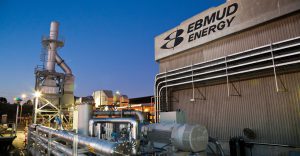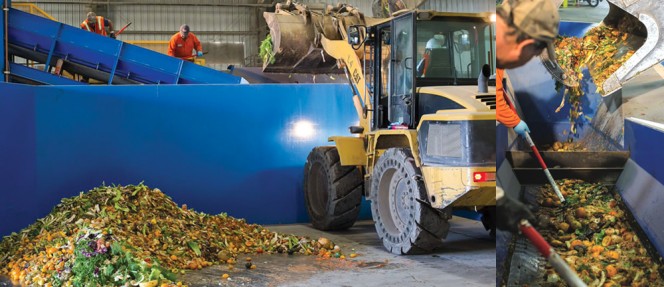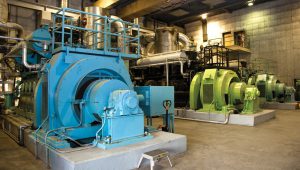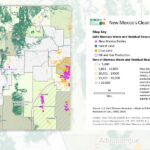“Traditional” WWTPs with anaerobic digesters are adding high strength food waste and FOG to become Water Resource Recovery Facilities with significantly smaller carbon footprints. Part I
Marsha Johnston
BioCycle June 2015

The East Bay Municipal Utility District (EBMUD) in Oakland, California, was an early pioneer in codigestion at water resource recovery facilities (WRRFs), utilizing its excess digester capacity to process food waste streams. Photo courtesy of EBMUD
From northwestern Indiana to the hills of Marin County, adding high strength food waste and FOG (fats, oils, grease) to their digesters is enabling traditional wastewater treatment plants to transition to water resource recovery facilities (WRRFs), cutting normally high energy use to the bone. The additional biogas has also enabled some facilities to become reliable net suppliers of energy to the grid.
While introducing the presentations about five exemplary facilities on an EPA webinar in March (2015), Charlotte Ely, life scientist for the Sustainable Water Infrastructure Program at the U.S. Environmental Protection Agency’s Pacific Southwest Region, reminded participants how energy-intensive it is to treat wastewater. “Wastewater resource recovery facilities use 30.2 billion kilowatt hours per year, or 0.8 percent of national electricity use, often accounting for 30 to 40 percent of the energy consumed by a municipal government,” Ely said.
The webinar presenters were featured in the EPA’s report, Food Waste to Energy: How Six Water Resource Recovery Facilities are Boosting Biogas Production and the Bottom Line. The report details the codigestion project development and practices of six WRRFs: East Bay Municipal Utility District, Oakland, CA (EBMUD); Central Marin Sanitation Agency, San Rafael, CA (CMSA); Hill Canyon Wastewater Treatment Plant, Thousand Oaks, CA (HCTP); Sheboygan Regional Wastewater Treatment Facility, Sheboygan, WI; West Lafayette Wastewater Treatment Utility, West Lafayette, IN; and Janesville Wastewater Treatment Facility, Janesville, WI. Janesville did not participate in the webinar.
When codigestion pioneer EBMUD was trying to figure out a creative use for its excess digester capacity back in the 1980s, “we realized that food waste would always be in our backyard, and had a high energy potential,” said Sophia Skoda, a civil engineer at EBMUD who managed the Resource Recovery Facility from 2006 to 2014. Adding 200 tons/day of food waste to a digester processing wastewater solids can generate 2 MW of energy from the resulting gas, she added. EBMUD installed three 2.2-MW Enterprise engines with GE generators and started taking in FOG, chicken blood, wine waste. By 2012, EBMUD added a 4.5 MW Solar Turbine Mercury 50 and became the first WRRF in the country to be a net seller of electricity to the grid, Skoda noted.
Although some WRRFs resist food waste and FOG because of potential waste stream contamination and their often corrosive nature, HCTP superintendent Chuck Rogers said: “The aforementioned wastes are typically scorned by other wastewater treatment plants that see them as a liability. I see them as a resource, and the higher the COD [Chemical Oxygen Demand], the better.” Last year, HCTP became a 100 percent renewable energy installation because of the added FOG and food wastes. When HCTP first pumped FOG into its digesters, recalled Rogers, there was “a wild increase” in gas production. “We put those same pumps on a timer and tried to normalize it a little bit, but there was no question about it, we had discovered that we could make a lot more gas.” Shortly after, he gave the Thousand Oaks City Council a commitment to take the facility off-grid, which he achieved in three years.
By diverting food waste from landfills to WRRF digesters, communities reduce GHG emissions by capturing and combusting landfill methane otherwise released into the atmosphere and by minimizing truck emissions associated with hauling waste further distances. In HCTP’s case, Rogers learned that the local FOG hauler was going to Los Angeles, “which is about an hour trip … and the traffic is kind of dreadful here in southern California, so the hauler was real happy to have a place that’s close to go to,” he recounted. He added that installing FOG receiving facilities “is really dictated in large part by geography.”
Finally, in an era of tight government budgets, boosting biogas production by codigesting food waste may help bridge funding gaps. Over the next 20 years, the country nationally faces a shortage of $298.1 billion for wastewater and storm water infrastructure needs, according to the U.S. EPA report. Historically, the federal government provided about 70 percent of the funds needed to build and upgrade treatment plants, but today provides only about 25 percent of public funding for water infrastructure projects, in part due to the dissolution of its construction grants program.
Since then, the federal government’s largest contribution to America’s wastewater infrastructure has been through the U.S. EPA’s Clean Water State Revolving Fund (CWSRF), which has provided $100 billion in low-interest loans over the last 25 years. But $100 billion is only one third of the projected need for wastewater infrastructure. At the same time, many cities spend more money than they take in on providing sewer services. Between 1991 and 2005, local governments, on average, generated only 88 percent of the funds expended on sewer services, according to the EPA report.
Part I of this article includes the following case studies: Central Marin Sanitation Agency and East Bay Municipal Utility District. Part II, in the July issue of BioCycle, will include Hill Canyon Wastewater Treatment Plant, West Lafayette Wastewater Treatment Utility and Sheboygan Regional Wastewater Treatment Facility.
Central Marin Sanitation Agency

Central Marin Sanitation Agency (CMSA) in San Rafael, California joined forces with Marin Sanitary Service (MSS) to launch the Commercial Food-2-Energy Initiative (F2E). Food scraps collected by MSS are loaded (left) onto a sorting line supplied by West Salem Machinery, where contaminants are removed (right). After grinding, the food scraps are taken by MSS to CMSA for codigestion. Photos courtesy of Marin Sanitary Service
With a lot of common customers, CMSA and Marin Sanitary Service (MSS) launched the Central Marin Commercial Food-2-Energy Initiative (F2E) in January 2014. CMSA, the regional wastewater agency for San Rafael (Marin County), serves about 120,000 customers, treating up to 6 billion gallons/year of wastewater, with an average dry weather flow (ADWF) of 7 million gallons/day (MGD), and the capacity to treat 125 MGD. The WRRF has two anaerobic digesters, with a combined capacity of approximately 2 million gallons (MG). MSS, a regional solid waste company based in San Rafael, collects 250,000 tons annually of solid waste from 30,000 residential and 3,000 commercial customers in nine jurisdictions.
F2E is a public-private partnership between CMSA and MSS. The idea for F2E dates back to January 2008, when the city manager in San Rafael got a letter from Pacific Gas & Electric saying there were grant monies available for feasibility studies of projects that would reduce greenhouse gases, recalled Jason Dow, CMSA general manager: “On that big [project] list was anaerobic digestion.”
CMSA, MSS and the City of San Rafael conducted a study in 2008/09 to quantify the amount of food waste in the solid waste collected by MSS. It found that 27 percent of residential and 35 percent of commercial solid waste was food waste. Multiple presentations to cities, towns and boards of supervisors in 2009 and 2012 garnered resolutions of support from elected officials, and led to integrating the F2E design into a bigger digester rehabilitation project. Dow said the rehabilitation included replacing the original two floating steel covers with membrane covers, the original gas mixing system with a pump mixing system, and installing additional biogas purification equipment to remove hydrogen sulfide.
Construction at CMSA for the project, including engineering design, ran $2 million, while food waste processing equipment for MSS totaled $530,000, Dow noted. The agencies did not have to raise rates for the digester rehabilitation or the F2E project, as they were paid through a share of approximately $12.5 million in unanticipated revenue bond proceeds. MSS’s annual operational costs (collection, processing, disposal, outreach and education) total approximately $315,000, and are paid through fees for resource hauling (recycling, organics and garbage), says Kim Scheibly, Municipal Contracts & Communication Manager at MSS.
After identifying 250 businesses that could provide a minimum of 32 gallons/week of preconsumer food waste (MSS services a few very small restaurants that only fill a 32-gallon cart once or twice a week), MSS hired dedicated outreach staff and began recruiting F2E customers. Each F2E customer signs a partnership agreement and, for 70 percent of MSS’s regular solid waste charge, gets signage, slim jim bins and training. Although taking initially only preconsumer food waste, MSS has allowed F2E participants to add postconsumer “once they have proven that they can keep the contamination close to zero with preconsumer scraps,” explained Scheibly, adding that four restaurants have successfully made this move. As of March 2015, the F2E program had 104 participants. There are nine grocery stores, two caterers and one school; restaurants comprise the balance. “Our goal is to reach 250 participants,” she added.
After CMSA and MSS signed their official partnership agreement in 2013, the first loads of FOG (from a separate program) and food waste came in January 2014. With the 104 customers, the program is processing approximately 26 tons/week. The CMSA digester has capacity to process 15 tons/day.
MSS collects and transports the food waste to its transfer station where people at a sort line supplied by West Salem Machinery remove all solid material that can’t be digested or could cause problems in the piping, explained Dow. A magnet removes metals. Early on in the collection program, one of the initial loads was full of plastic gloves because Marin County Environmental Health Services requires restaurant kitchen staff to wear gloves, which were put in with the food waste. But the gloves, as well as rubber bands and metal pieces used to bundle vegetables, disappeared from the food waste after MSS reeducated participants. “When the driver picks up containers, he checks for contaminants in the carts, or in the truck or when it’s dumped at the transfer station, and he pulls out anything he sees,” said Dow. “That has been very, very successful.”
Contaminant-free material is ground to the size of a thumbnail with a West Salem hammer shredder, dumped into a storage box, trucked down the street to CMSA’s plant, where it is unloaded into underground tanks, and mixed with Vaughan chopper pumps. MSS pays a tipping fee of $20.50/ton delivered. CMSA and MSS are signatory to a five-year Food Waste Processing and Disposal Agreement. CMSA is receiving an average of 4.2 tons/day of food waste from MSS. It also receives up to 15,000 gallons/day of FOG.
A Brown Equipment drum screen paddle finisher screens out bigger chunks that go into a dumpster. “Most of that is not contaminants, but chunks of banana peel, melon rinds, fibrous material from corn and other similar type products,” he added. “MSS picks up this material once a week, combines it with green waste and residential food waste and it is composted.”
The resultant slurry is pumped through peristaltic pumps over several hours to the anaerobic digesters retrofitted with pump mixers and new Siemens membrane covers. Biogas from the digesters goes through a new Biorem SulfaTreat scrubber that CMSA installed as part of a bigger project to remove hydrogen sulfide, Dow explained. Biogas production almost doubled from 127,000 cubic meters (m3) to 225,000 m3/day. “We pressurize the gas, send it through a heat exchanger and a gas dryer to cool the gas and remove all of the moisture, and through scrubbers with media designed to remove siloxane.” The clean, dry gas (equal to about 600 kW of electricity) goes to a 750 kW Waukesha generator; power is used to run the buildings and the plant approximately 17 hours/day (natural gas is used for the other 7 hours).
Dow noted that the operational health of the digester has not been affected by the addition of food waste, adding that the CMSA digesters have a significant amount of unused or available capacity. For example, if CMSA were to receive 20 tons of additional food waste per day, the plant would be energy self-sufficient and begin to export energy. In the future, it might be possible to put the biogas into the pipeline or turn it into vehicle fuel. If F2E continues to get more food waste, Dow would also consider dedicating one of the two digesters to food waste only. For its part, MSS is securing more food waste. “We are in the process of negotiating a contract with Mill Valley Refuse Service,” said Scheibly. They will collect food waste from grocery stores they service and deliver it to Marin Sanitary Service for processing before it is sent to CMSA for further processing and digestion.”
East Bay Municipal Utility District
In September 2014, Oakland City Council awarded its Mixed Materials and Organics collection franchise to Waste Management (WM) and directed that commercial organics be taken to EBMUD. As a result, EBMUD became a subcontractor to WM, and the District will be contractually responsible for commercial food scraps beginning July 1, 2015. EBMUD expects that for the one-year start-up period, material will be diverted to composting operation(s). It expects to begin processing food scraps on site by July 1, 2016.

EBMUD is selling the approximately 30 percent excess power generated (biogas engines shown above), making it an energy net positive WRRF. Photo courtesy of EBMUD
Currently, the District processes 10 tons/day of clean, ground solid waste from Contra Costa County Solid Waste Authority. To service the new contract with WM, EBMUD issued an RFP for Food Scraps Preprocessing and Organics Program Development in February 2015. On the EPA webinar, Skoda said that “several parties are engaged to build the 200 tons/day facility.”
EBMUD’s plan is to isolate one of its 12 digesters for food waste only. Segregating that food waste, added Skoda, would mean less use of polymers to wick away water from the biosolids during the dewatering process. “Segregating the food waste, which tends to bind better, could cut our processing cost with respect to dewatering. It is also easier to isolate the impacts of contamination if food waste is segregated.”
As for energy production, EBMUD is selling the approximately 30 percent excess generated, making it an energy net positive WRRF. The plant has adequate space to add an additional 4.5 MW turbine to utilize the biogas generated by the additional food waste to be processed.
Marsha Johnston, principal of Earth Steward Associates in Arlington, Virginia, is a Contributing Editor to BioCycle.












